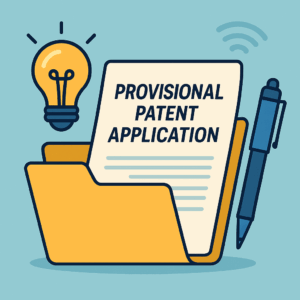 When discussing patents, one common misconception often needs immediate clarification: there is no such thing as a “provisional patent.” What inventors can file is a provisional patent application—a strategic tool that, when used correctly, offers significant benefits in today’s patent system.
When discussing patents, one common misconception often needs immediate clarification: there is no such thing as a “provisional patent.” What inventors can file is a provisional patent application—a strategic tool that, when used correctly, offers significant benefits in today’s patent system.
What Is a Provisional Patent Application?
A provisional patent application (PPA) is a legal document filed with the United States Patent and Trademark Office (USPTO) that establishes an early filing date for an invention. While it never matures into an issued patent by itself, it plays a critical role in the patent process—especially now that the U.S. follows a first-to-file system. This means whoever files a patent application first—regardless of who invented first—gets the rights. Filing a PPA early can preserve your rights even as you continue to develop your invention. For more information read: Provisional Patent Application
Why Was the Provisional System Created?
The PPA was introduced on June 8, 1995, to address a shift in patent term law. Prior to that date, U.S. patents lasted 17 years from issuance. After the change, patent term is measured as 20 years from the earliest non-provisional filing date.
This change could have disadvantaged U.S. inventors, who must often file domestically to get a foreign filing license. Filing a full non-provisional patent would start the patent term clock, while foreign inventors could delay that clock by filing in their home country first.
To level the playing field, Congress introduced the provisional patent application, which:
-
Locks in a filing date (priority),
-
Doesn’t start the 20-year patent term clock,
-
Can be filed by both U.S. and foreign inventors.
Key Benefits of Filing a Provisional
Filing a PPA comes with distinct advantages:
-
Early Priority Date: Secures your place in line in the patent office.
-
Lower Cost: Filing fees are significantly lower than for a non-provisional application. As of this writing:
-
Small entity: $150
-
Micro entity: $75
-
(Compared to $910/$405 for a non-provisional.)
-
-
Simplified Process: No formal claims, declarations, or oaths are required.
-
“Patent Pending” Status: You can legally mark your invention as “patent pending” once the PPA is filed.
Important Deadlines and Limitations
A PPA has a strict 12-month pendency. During that year, you must file a non-provisional application that claims the benefit of your PPA.
In very limited and costly circumstances, you may get a 2-month extension, but only for clerical errors—and with hefty fees attached. Therefore, always treat the 12-month deadline as absolute.
For more information see: What happens when you file a provisional patent application and what is the deadline for the next step?
Don’t Be Misled by the Simplicity
Despite its lower cost and relaxed formalities, a provisional must still describe your invention as completely as a non-provisional would. A vague or underdeveloped provisional can fail to provide protection—or worse, act as evidence that you didn’t fully conceive the invention when you claimed.
A Smart Filing Strategy
Why use a provisional if you need to describe the invention in full? The answer lies in its strategic flexibility.
As soon as your invention is well-developed enough to describe, you should consider filing a PPA to lock in your filing date. If you continue developing or improving the invention, you can file additional provisional applications.
When it’s time to file a non-provisional, you can claim priority to all provisional applications filed in the previous 12 months—ensuring the earliest possible protection while incorporating all versions and improvements.
Final Thoughts
The provisional patent application is a powerful tool, but only when used thoughtfully and correctly. By filing early, filing often, and fully describing your invention each time, you can protect your innovation in the competitive, first-to-file world of U.S. patent law.
Just remember: a poorly prepared provisional can do more harm than good. If you’re serious about protecting your invention, invest the time—or get professional help—to do it right from the beginning.



